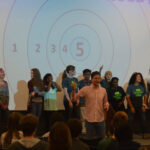As we turn our full attention to Red Rover, I think it is important, and fun, to put the product in context.
We started Red Rover with the intent of building a tool that encapsulated Dance Floor Theory™ leadership training and pushes forward the Swift Kick mission. A what to go with the hows that we’ve been delivering all over the country.
We’ve always felt that training is important and it is sometimes inefficient at its best. (With training, our change is subjected to the vagaries of memory, timing, college students sleeping patterns, etc. We can always get better, but there is only so much we can control.)
A bit of software, however, acts consistently based on the philosophies embedded into it – it delivers training to the user experientially – our favorite way.
So Swift Kick provides training and tools to move students from apathy to engagement. The training and tools complement each other, working in the same way towards the same end.
Red Rover is our first tool.
Our development conversations over the last 6 months have gone from big picture thinking “What are the challenges of student activities and student leaders?” to the very focused “What is the one challenge of student activities that can be solved without IT’s heavy involvement and without marketing clutter?”
In other words – what one thing can we do well that no one else is doing.
Once Red Rover is in the institution, there are tremendous opportunities for 21st century, web 2.0 style applications, but we do not want to sell a 21st century product.
This was an epiphany for me personally, coming from the “Next Big Thing*” generation:
We don’t want to sell “revolution” to school.
We want to provide obviously.
Here’s our obvious:
Freshman Experience of Orientation:

Freshman Experience of Orientation with Red Rover

Because everyone appreciates a good introduction.
With a link embedded into registration, the student fills out a profile. Based on this profile, Red Rover matches group and activities possibilities and provides individualized recommendations. The student confirms interest in groups and the group leaders are then given access to communication channels and the digital identity of the new student. Assessment is built right in, completely transparent to everyone.
Got it?
Obvious enough? Oh, yeah, and this software is delivered over the web, will not require technical anything to set up, and last but not least, it is cheap. $5,000 or less, so every school can afford it.




